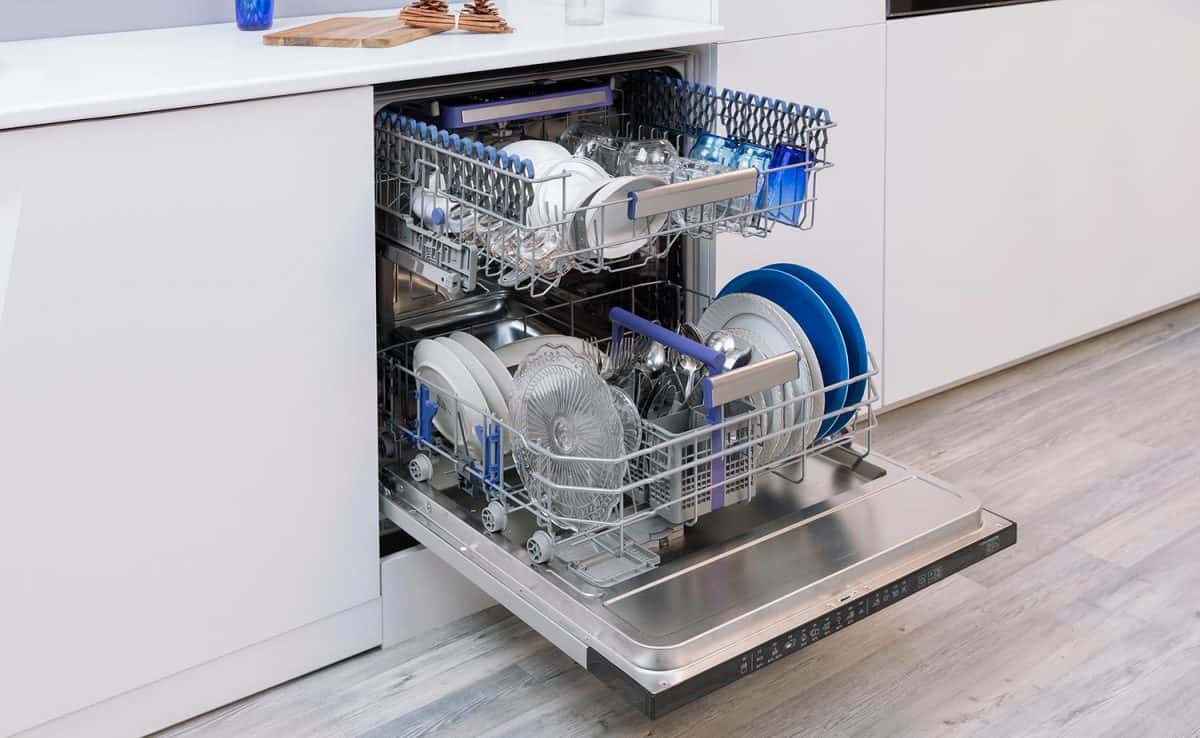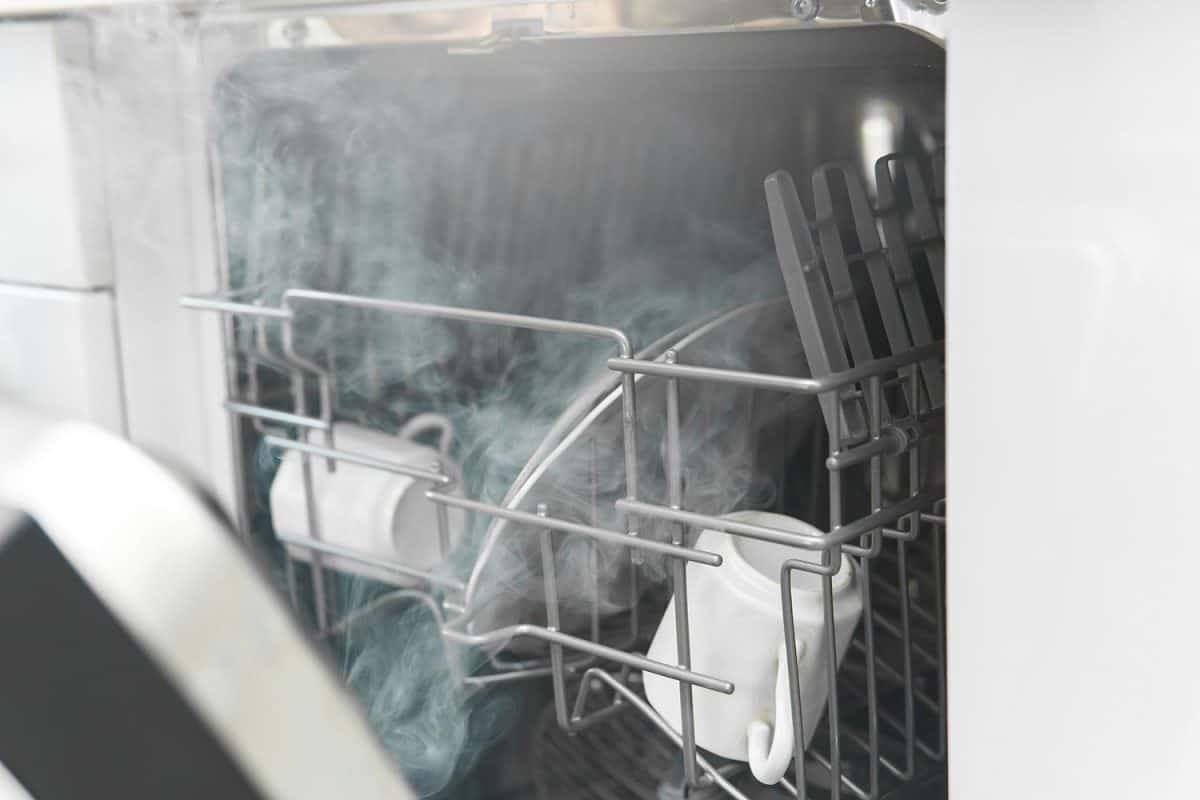If you've recently bought a new dishwasher, you might be disappointed to find out it doesn't look quite the same as the old one. Is this dishwasher the wrong size? Do dishwashers even come in other sizes? In any case, now you need to know how to fill the gap between the dishwasher and the countertop. We've checked with contractors for their best solutions to this problem.
The easiest way to fill a gap between the dishwasher and the countertop is to elevate the dishwasher. There are two simple ways to do this—we'll explain them both in detail.
But why was the gap there? Is there supposed to be a gap between the dishwasher and the countertop? And aren't dishwashers all the same size anyway? Is something missing that was supposed to be installed in that gap? We'll cover all this and more, so keep reading!

How To Fill Gap Between Dishwasher And Countertop
There are two fairly easy ways to fill a gap between the dishwasher and countertop. They are to:
- Raise the dishwasher's adjustable feet.
- Elevate the dishwasher with shims, and then cover with a toe plate if necessary.
Raise The Dishwasher
This one is pretty obvious. But some people may not realize they can just raise the dishwasher. This is the simplest solution, so it's worth checking into.
Most dishwashers have adjustable feet. This makes it easier to fit it snugly into a pre-cut rough opening. Check and see if you can raise the dishwasher a bit higher, eliminating the gap.
Usually, the door of the dishwasher stands a bit higher than the rest of the machine. As a result, you can leave a small gap between the dishwasher and countertop. But thanks to the door, you won't have to see it.

Elevate The Dishwasher With Shims
Ultimately, the goal is to lift the dishwasher so that you don't see a large gap between it and the countertop. The easiest way is to adjust the legs. But what if the dishwasher is already as high as it can go?
Well, then you'll need to help it get a bit higher yourself. Measure the gap first and figure out just how high you need to elevate the dishwasher. You can then install a 2x4 piece of plywood on either side (or a thinner piece of wood if that's all you need).
Whatever you choose, get two pieces of wood that are long enough to lift two legs at a time. First, put one under both legs on the right side. Then, put the other plank of wood under both legs on the left side. This is necessary because it provides the most stability.
Once you've gotten it where you want it, use a leveling tool to ensure the dishwasher is pretty stable and square. There is usually a metal plate in the front of the dishwasher. This piece may extend down, making it easy to cover your wood extensions.
If it doesn't, you can simply add your toe kick. Find a thin piece of wood or molding. Paint it to match your decor or dishwasher. Just screw it into the wood planks holding up the dishwasher, and no one will ever notice.
Note: Don't raise the dishwasher too high. A slight gap is necessary to let heat and moisture out without damaging your cabinets. Plus, you may block the dishwasher door from opening. So just be careful - only raise it as far as you need to hide a large gap.
How Much Gap Should There Be Between Dishwasher And Countertop?
The amount of gap necessary between the dishwasher and countertop is usually set by the manufacturer. Always follow the manufacturer's recommendations for the best results.
The gap is necessary because dishwashers create a lot of heat and humidity. It can damage the counters to be exposed to these elements too closely. Most manufacturers recommend a gap of 1/2-3/4 of an inch.

Are Dishwasher Sizes Standard?
Dishwashers might not all be exactly the same size, but they follow a rough standard. This ensures that most dishwashers fit within the same opening. As a result, your new dishwasher will almost always fit into the same rough opening as your old one.
The typical rough opening for a dishwasher is 24 inches wide, 24 inches deep, and 34-36 inches high. If your dishwasher doesn't quite fit the exact height, check to see if the feet are adjustable. Most are, and this makes fitting a new dishwasher into your current opening a bit easier.
A compact dishwasher has the same depth and height rough opening measurements. But the width is 18 inches. Similarly, an oversized dishwasher requires the same depth and height - with a width of 30-42 inches.
For more information on dishwasher sizes, read: What's The Typical Dishwasher Height? [Inc. ADA Dishwashers]
What Goes Around A Dishwasher?
Dishwashers typically come with an insulation blanket. You might think it's just packing material. But it's an important piece that needs to go around the dishwasher.
The insulation blanket keeps in the heat from the dishwasher. This protects your nearby surfaces from too much damaging heat. It also helps reduce the noise since it absorbs and dampens sound.
Accidentally threw out your insulation? Or is your dishwasher too loud, making you think it's time for a better blanket? No worries - find some ceramic fiber insulation.
Ceramic fiber is one of the best choices for a dishwasher. It has some of the best protection against sound, vibration, and heat. For example, this one is rated for up to 2400 degrees Fahrenheit!
Click here to see this insulation on Amazon.
How Hot Does A Dishwasher Get?
If you think that insulation rated to withstand temperatures of 2400 degrees is overkill...well, you're probably right. Ceramic fiber insulation is useful for lots of things, not just dishwashers. Does your dishwasher need insulation that can get that hot safely? Not really.
A dishwasher can get pretty warm during the cleaning cycle, though. An older dishwasher will only achieve water temperatures as high as your home's water heater allows. Typically, this is somewhere between 120-140 degrees (depending on your settings).
Newer dishwashers may have their own internal heaters to make cleaning a bit more efficient. For example, some dishwashers claim to have sanitizing properties. Dishwashers must reach 150 degrees Fahrenheit during the final extended hot water rinse to be able to say they can sanitize, according to the National Sanitation Foundation.
Water isn't the only thing making your dishwasher hot. A heating element used during the drying cycle can heat the dishwasher anywhere from 110 to around 170 degrees.
Should The Dishwasher Be Flush With The Cabinets?
Usually, the dishwasher door is not flush with the cabinets. The only exception is fully integrated dishwashers.
A fully integrated dishwasher sits flush to the cabinets. The control panel is also hidden inside the door. As a result, these dishwashers are undetectable. You wouldn't know, to look, that it's even a dishwasher.

You can read more about integrated dishwashers here: Do Integrated Dishwashers Need A Cabinet?
But standard dishwashers, on the other hand, usually protrude out a few inches. The front of the dishwasher (not the door) is flush with the cabinets. The door itself sticks out just past the cabinets.
Read more about dishwasher placement here:
In Closing
Most dishwashers are about the same standard size, and as a result, your new dishwasher should fit into the space left by your old one. The exception to this, of course, is oversized or compact dishwashers. However, even oversized or compact dishwashers tend to come in standard sizes, making swapping an old and new machine easier.
If your dishwasher has a gap between it and the countertop, you can try adjusting the legs. Most machines have adjustable feet for this purpose. If that doesn't help, elevate the dishwasher with two planks of wood under the left and right legs. The metal plate at the bottom of the dishwasher usually extends to cover the "risers." If it doesn't, you can simply cover the gap at the bottom with a piece of painted wood or molding.




![This modern kitchen gives a wide view showing the wood floor and cabinets, How Tall Are Kitchen Cabinets? [3 Types Examined]](https://kitchenseer.com/wp-content/uploads/2020/07/This-modern-kitchen-gives-a-wide-view-showing-the-wood-floor-and-cabinets-250x250.jpg)


